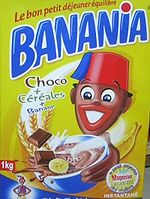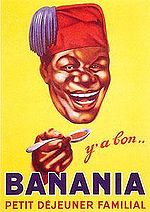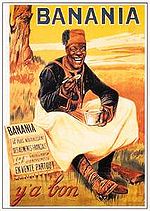
Banania
Encyclopedia



Chocolate
Chocolate is a raw or processed food produced from the seed of the tropical Theobroma cacao tree. Cacao has been cultivated for at least three millennia in Mexico, Central and South America. Its earliest documented use is around 1100 BC...
drink found most widely distributed in France
France
The French Republic , The French Republic , The French Republic , (commonly known as France , is a unitary semi-presidential republic in Western Europe with several overseas territories and islands located on other continents and in the Indian, Pacific, and Atlantic oceans. Metropolitan France...
. It is made from cocoa
Cocoa solids
Cocoa solids are the low-fat component of chocolate. When sold as an end product, it may also be called cocoa powder, cocoa, and cacao....
, banana flour, cereals, honey
Honey
Honey is a sweet food made by bees using nectar from flowers. The variety produced by honey bees is the one most commonly referred to and is the type of honey collected by beekeepers and consumed by humans...
and sugar
Sugar
Sugar is a class of edible crystalline carbohydrates, mainly sucrose, lactose, and fructose, characterized by a sweet flavor.Sucrose in its refined form primarily comes from sugar cane and sugar beet...
. There are two types of Banania available in French supermarkets: 'traditional' which must be cooked with milk for 10 minutes, and 'instant' which can be prepared in similar fashion to Nesquik.
History
During a visit near Lake ManaguaLake Managua
Lake Managua is a lake in Nicaragua. The Spanish name is Lago de Managua or Lago Xolotlán. At 1,042 km², it is approximately long and wide. Similarly to the name of Lake Nicaragua, its name was coined by the Spanish conquerors from "Mangue" and agua...
, Nicaragua
Nicaragua
Nicaragua is the largest country in the Central American American isthmus, bordered by Honduras to the north and Costa Rica to the south. The country is situated between 11 and 14 degrees north of the Equator in the Northern Hemisphere, which places it entirely within the tropics. The Pacific Ocean...
, in 1909, the journalist Pierre Lardet discovered the recipe for a cocoa-based drink. When he returned to Paris
Paris
Paris is the capital and largest city in France, situated on the river Seine, in northern France, at the heart of the Île-de-France region...
, he started its commercial fabrication and, in 1912, began marketing Banania with the picture of an Antillaise. Her image was replaced in 1915 with the drawing of a widely smiling Senegalese man.
At the outset of World War I
World War I
World War I , which was predominantly called the World War or the Great War from its occurrence until 1939, and the First World War or World War I thereafter, was a major war centred in Europe that began on 28 July 1914 and lasted until 11 November 1918...
, the popularity of the colonial troops at the time led to the replacement of the West Indian by the now more familiar jolly Senegalese infantry man
Senegalese Tirailleurs
The Senegalese Tirailleurs were a corps of colonial infantry in the French Army recruited from Senegal,French West Africa and throughout west, central and east Africa, the main province of the French colonial empire...
enjoying Banania. Pierre Lardet took it upon himself to distribute the product to the Army, using the line pour nos soldats la nourriture abondante qui se conserve sous le moindre volume possible ("for our soldiers: the abundant food which keeps, using the least possible space").
The brand's yellow background underlines the banana ingredient, and the Senagalese infantryman's red and blue uniform make up the other two main colours. The slogan Y'a bon ("It's good") derives from the pidgin
Pidgin
A pidgin , or pidgin language, is a simplified language that develops as a means of communication between two or more groups that do not have a language in common. It is most commonly employed in situations such as trade, or where both groups speak languages different from the language of the...
French supposedly used by these soldiers (it is, in fact, an invention). Slowly but surely, the slogan and the character became inseparable as the expression was coined: l'ami y'a bon ("the y'a bon buddy").
The form of the character has since evolved, so that now all that remains is the name. However, the original advertising has become a cultural icon in France. Posters and reproduction tin-plate signs of the pre-war advertising continue to be sold.
In the 1970s and early 1980s, Banania sponsored the Yellow Jersey
Yellow jersey
The general classification in the Tour de France is the most important classification, the one by which the winner of the Tour de France is determined. Since 1919, the leader of the general classification wears the yellow jersey .-History:...
of the Tour de France
Tour de France
The Tour de France is an annual bicycle race held in France and nearby countries. First staged in 1903, the race covers more than and lasts three weeks. As the best known and most prestigious of cycling's three "Grand Tours", the Tour de France attracts riders and teams from around the world. The...
. In France the Banania brand is now owned by the newly-founded French company Nutrial, which acquired it from Unilever in 2003.
Controversy
The advertising slogans and images have been labelled racistRacism
Racism is the belief that inherent different traits in human racial groups justify discrimination. In the modern English language, the term "racism" is used predominantly as a pejorative epithet. It is applied especially to the practice or advocacy of racial discrimination of a pernicious nature...
and colonialist
Colonialism
Colonialism is the establishment, maintenance, acquisition and expansion of colonies in one territory by people from another territory. It is a process whereby the metropole claims sovereignty over the colony and the social structure, government, and economics of the colony are changed by...
by some who argue that it reinforces the old cliché of a friendly yet stupid African. Some French black people connect this stereotype with aggressive colonialist policy in Africa of the global group Unilever
Unilever
Unilever is a British-Dutch multinational corporation that owns many of the world's consumer product brands in foods, beverages, cleaning agents and personal care products....
, the old unique owner of the brand. Martiniquan psychiatrist and philosopher, Frantz Fanon
Frantz Fanon
Frantz Fanon was a Martiniquo-Algerian psychiatrist, philosopher, revolutionary and writer whose work is influential in the fields of post-colonial studies, critical theory and Marxism...
in his 1952 book Black Skin, White Masks
Black Skin, White Masks
Black Skin, White Masks is a 1952 book written by Frantz Fanon originally published in French as Peau noire, masques blancs.In this study, Fanon uses psychoanalysis and psychoanalytical theory to explain the feelings of dependency and inadequacy that Black people experience in a White world...
mentions the grinning infantryman as an example of how in a burgeoning consumer culture, the Negro appears not only as an object, but as "an object in the midst of other objects".

